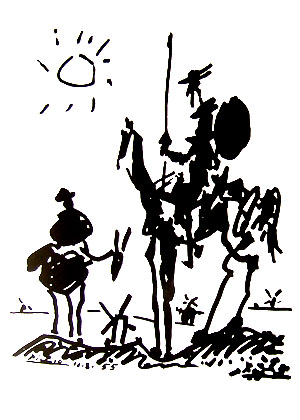Verticality, Posture, and the Use and Misuse of Gravity
Humans are the only animals that have a fully upright posture. This is a very social and vulnerable position. It also presents unique requirements for the pelvis. The pelvis is critical for balance, alignment, and dynamic movement. Posture is the idea that there is a preferable 'form' in which to stand. Posture is a static concept that does not easily translate to movement. Verticality (a term coined by Moishe Feldenkrais) is a dynamic concept that translates much more readily to movement. Verticality implies not exactly a preferable 'form' to stand, but rather a harmonious relationship between the skeleton, the muscles, and gravity.
Another distinction to make is between stability and balance. Stability is using leverage to prevent tipping or falling. Large machinery is made to be stable by having a flat wide base and a low center of gravity. Even if the weight is not balanced, tipping over is hard. But movement is awkward--think of walking a refrigerator across the floor. Balance is different, it uses alignment in a way that gravity keeps the structure upright. With balance, movement, up or down or parallel to the ground is easy. With stability, if a force is applied from the outside, nothing happens, unless the force is quite strong, and then damage is a possibility. With balance, if a force is applied from the outside, balance is regained with movement. Balance interacts with environment, whereas stability does not.
It has been said that walking is a controlled fall. All graceful movement is a controlled fall in that gravity is leveraged in some part. Adaptation to gravity can be awkward or graceful. Many people, lacking balance, try for stability instead. This is done by lowering the center of gravity (hunching over and stooping), taking a very broad stance and wearing shoes (flat wide base), and 'locking' the joints. All this works against movement. When movement is attempted from this position, steps are small, with the foot planted first and then weight tentatively loaded over it (the opposite of natural walking) Also there is a tendency to hold on to inanimate objects 'for balance' (really stability). Where stability is the mode of the body, attempts to sustain movement, like in dancing, will not flow because the person is constantly 'stopping' to reattain stability. With balance it is not necessary to stop until one wants to.
Collapse, in a bodily sense, is where the stabilizing muscles in the trunk let go quickly. When this happens, the person achieve more or less the shape of a ball. Collapse originates in early experience where there was insufficient emotional support, and instrumental activity is attempted prematurely. The limbs and head end up being moved using the collapsed mass of the trunk as a platform of sorts which because of sheer mass can be pushed against awkwardly. This provides a mediocre stability and often the other three limbs are recruited as struts to prop up the trunk. The practice leads to an arrest in development in which effort and intention actually becomes a cue to the trunk for collapse (and often for the limbs to freeze or extend rigidly). This is why Pilates is organized around developing 'the core,' it is an 'anti-collapse' discipline. Emotional strength comes from core strength.
When there is not good alignment and flexibility in the feet ankles legs and pelvis, (and this tends to be the rule not the exception) there is always present a fear of falling. Fear of falling has far reaching emotional effects of course, but these stem from the physical effects. With fear of falling, all movement is distorted to avoid gravity. Gravity is fought all the time, which is exhausting.
Graceful movement on the other hand is based on a secure feeling. Graceful movement is pleasureable. This is the experience of children (for the most part). Children often cannot not move. Adults of course must learn to be more judicious in movement, but this does not mean growing out of the pleasure of movement. Traditionally dancing is a form of shared pleasure in movement. In the first half of the twentieth century, community dances were abundant. Perhaps this was a way to provide a shared experience of pleasure for young men and women that didn't involve sexual intercourse, consistent with the mores of the time.
The type of dancing that is prevalent in the second half of the twentieth century and now is more akin to shaking or rocking. This may have a neuro-muscular impetus and benefit, but it also perhaps disguises an increasingly distorted verticality and fear of falling. There is no leading and following and so the pleasure is not shared although there may be pleasure simultaneously with others (parallel play).
Ida Rolf believed that humans would actually take energy from gravity if the body was oriented to gravity in a correct way. She believed that beliefs about a 'subtle energy body' arose from the experience of effortless and plentiful energy that occurred for some people when excellent-enough alignment happened. Like all phenomena of excellence, this is rare, and scientifically unprovable
